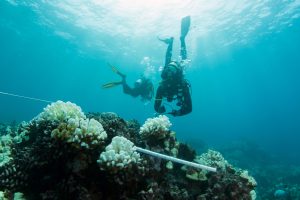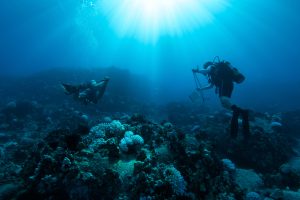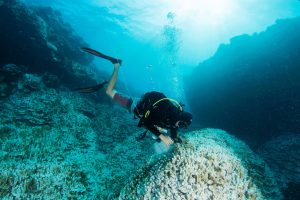Researchers Assess West Hawai‘i Reefs
A recent study by The Nature Conservancy of Hawai‘i, the National Oceanic and Atmospheric Administration and the Marine Applied Research Center revealed how reefs can recover from a major bleaching event that occurred in 2015.
Coral reefs in West Hawai‘i vary in their response to climate change, and that variation can help managers develop strategies to keep these reefs alive, according to the study.
Researchers sought to assess the condition of the reefs of South Kohala and North Kona, and to identify factors that lead to resilience—the ability of a reef to recover from extreme events such as coral bleaching.
The study looked at the reefs of West Hawai‘i after a major bleaching event in 2015 caused significant damage. At the sites surveyed, rates of partially or fully bleached coral colonies ranged from 38% to 92%, with more than a 90% mortality rate at some sites.
The goal of the study was to assess the condition of the reefs and to identify actions that managers and the community can take to help restore and protect their reefs and nearshore fisheries from further damage.
With the planet facing another record hot year, there is considerable urgency to the research.
“Ocean waters are getting hotter and more acidic, and that’s bad news for coral reefs,” said Dr. Eric Conklin, the conservancy’s director of marine science, who presented the study results at last week’s 13th International Coral Reef Symposium. “What we have been doing is not sufficient to protect reefs into the future, so the fundamental question is, what can we do to best assure reefs survive in a changing climate?”
Chad Wiggins, the Conservancy’s Hawai‘i Island marine director, said managers have limited resources to protect reefs and need to make tough choices about where and on what to work.
“To do this we need to understand which reefs have the best chance of surviving into the future,” said Wiggin. “This means understanding which reefs are healthiest, as well as which are doing poorly and why.”
To help answer those questions, the conservancy and its partners conducted detailed surveys along the West Hawai‘i coastline, with a focus on the reefs of North Kona and South Kohala. The work involved nearly 200 dives at 40 sites from Kawaihae to Keauhou.
“Our resilience assessments use the best available science to determine a reef’s relative ability to withstand warmer water and to recover quickly from bleaching,” Conklin said.
From that, the team hopes to identify management actions that can preserve or restore reef resilience to climate change.
Among their initial findings:
- Three major factors are most important in determining resilience in West Hawai‘i: which corals handle increases in water temperature best; which reefs have new corals readily settling on available surfaces; and how much of the reef has already been invaded by algae, which compete with coral.
- There is considerable variation from reef to reef but, generally, reefs in South Kohala had less bleaching and mortality than those in North Kona.
- Human threats impact reef health. These include overfishing of seaweed-eating fish, sedimentation and nutrient pollution, all of which make reefs less resilient and more susceptible to further damage.
“Rising sea surface temperatures are a threat to corals globally, but man-made threats are adding more stress to reefs in West Hawai‘i,” said Conklin. “To make our reefs more resilient, we need to manage the threats that we can, like reducing fishing pressure on fish that protect reef health by keeping them clean of harmful algae or reducing runoff of sediments from coastal development and nutrients from outdated wastewater treatment systems.”
The conservancy selected the Kona Coast, in part because it has been identified by both NOAA and the state as a particularly important coral reef site, and because the area’s community groups are concerned and engaged in managing their reefs.
The immediate next step is to present the survey results to government and community partners, so they can begin incorporating resilience into their management actions.
“While these initial results will be very useful to managers and those communities who rely upon reefs, repeating the assessment in 2016 to observe where and how reefs have recovered will improve our understanding of resilience in Hawai‘i—and our ability to keep reefs healthy and thriving into the future,” Wiggins said.
The study, funded by the NOAA Coral Reef Conservation Program, was co-authored by Jeffrey Maynard of the Marine Applied Research Center, and Jonathan Martinez, Danielle Jayewardene, Douglas Harper and Lani Watson, all of the National Oceanic and Atmospheric Administration.
The Nature Conservancy is a leading conservation organization working around the world to protect ecologically important lands and waters for nature and people. The conservancy and its more than one million members have protected nearly 120 million acres worldwide.
Visit The Nature Conservancy online.

















